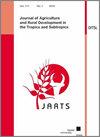Early planting and relay cropping: pathways to cope with heat and drought?
Q3 Social Sciences
Journal of Agriculture and Rural Development in the Tropics and Subtropics
Pub Date : 2021-05-05
DOI:10.17170/KOBRA-202104133652
引用次数: 3
Abstract
Maize ( Zea mays ) is an important food and cash crop of uplands in Southeast Asia, where it is often prone to drought and heat stress associated with climate change. This study aimed at assessing the effect of heat and drought on maize performance, testing coping strategies under such weather extremes, and understanding associated mechanisms. The experiment was carried out during 2018 in Thailand, using a split-plot design with three replications. Treatments were: July-planted maize sole cropping (control), July-planted maize-mungbean ( Vigna radiata ) relay cropping, and June-planted maize sole cropping. High temperatures and dry spells during July-August 2018 decreased maize growth strongest in the control and less so in maize relay cropping during generative growth stages, but not in June-planted maize sole cropping. Stress reduced maize nitrogen nutrition index by 40%. Relay-cropped maize had a significantly higher potential to keep stomata open (320 mmol m -2 s -1 ) than sole-cropped maize (100 mmol m -2 s -1 ). Δ 13 C of maize grains confirmed that June-planted maize (‑9.43‰) was less affected by dry spells and heat stress than July-planted sole cropped maize (‑10.23‰). Under relay cropping, the latter showed less water stress (δ 13 C: ‑10.12‰) compared to sole cropping and a higher soil water use. Maize was better able to cope with heat and drought stress when relayed-cropped, although less compared to early-planting of maize. Hence, the tested coping strategies are able to mitigate heat and drought effects on maize growth, while improving food security and crop diversification when relay-cropped with mungbeans.早期种植和中继种植:应对高温和干旱的途径?
玉米(Zea mays)是东南亚高地重要的粮食和经济作物,在那里,它经常容易受到与气候变化相关的干旱和热应激的影响。本研究旨在评估高温和干旱对玉米生产性能的影响,测试在这种极端天气下的应对策略,并了解相关机制。该实验于2018年在泰国进行,采用了三次重复的分块设计。处理为:7月种植玉米底(对照)、7月种植玉米绿豆(Vigna radiata)接力种植和6月种植玉米底。2018年7 - 8月的高温和干旱对玉米生长的影响在对照期最为明显,在生育生长期的玉米接力种植中影响较小,但在6月种植的玉米单作中影响较小。胁迫使玉米氮素营养指数降低40%。转播玉米保持气孔开放的潜力(320 mmol m -2 s -1)显著高于单播玉米(100 mmol m -2 s -1)。玉米籽粒Δ 13 C值证实,6月种植的玉米(- 9.43‰)受干旱和热胁迫的影响小于7月种植的单作玉米(- 10.23‰)。与单作相比,转作的水分胁迫较小(δ 13 C: - 10.12‰),土壤水分利用率较高。延期种植的玉米能够更好地应对高温和干旱胁迫,尽管与早期种植的玉米相比效果较差。因此,经过试验的应对策略能够减轻高温和干旱对玉米生长的影响,同时在绿豆转种时改善粮食安全和作物多样化。
本文章由计算机程序翻译,如有差异,请以英文原文为准。
求助全文
约1分钟内获得全文
求助全文
来源期刊
CiteScore
2.30
自引率
0.00%
发文量
0
审稿时长
>36 weeks
期刊介绍:
The Journal of Agriculture and Rural Development in the Tropics and Subtropics publishes papers dealing with original research and review papers in the fields of plant production, animal nutrition and animal husbandry, soil science, rural economy and farm management, forestry and forest economy, veterinary hygiene and protection against epidemics.

 求助内容:
求助内容: 应助结果提醒方式:
应助结果提醒方式:


